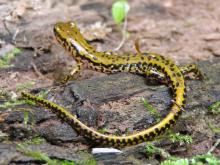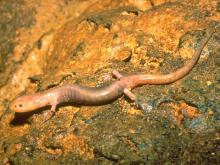Reptiles and Amphibians
Media

Species Types
Scientific Name
Trachemys scripta elegans
Description
The red-eared slider is an attractive aquatic turtle with yellow pinstripes and red ears. It is commonly seen basking on logs or rocks and occurs statewide, except for a few northern counties.
Media

Species Types
Scientific Name
Amphiuma tridactylum
Description
The three-toed amphiuma is an eel-like, completely aquatic salamander. It has very small forelimbs and hind limbs, each with three tiny toes. In Missouri it’s found only in the Bootheel region.
Media

Species Types
Scientific Name
Siren intermedia nettingi
Description
The western lesser siren is an eel-like, aquatic salamander with external gills, small eyes, small forelimbs with four toes, and no hind limbs. In Missouri, it’s found mostly in the Bootheel and northward in counties near the Mississippi River.
Media

Species Types
Scientific Name
Opheodrys aestivus aestivus
Description
The northern rough greensnake is a long, slender snake common in the Ozarks. It is light green above with a white or yellowish belly. The scales on the back have small ridges that feel rough to the touch. Its beautiful green color helps this mild-mannered insectivore blend in with tree leaves.
Media

Species Types
Scientific Name
Opheodrys vernalis
Description
The smooth greensnake has been declared extirpated from Missouri. If it is ever found again within our borders, it will probably be as small, relict populations in grasslands in the extreme northern counties. It differs from the similar rough greensnake by having smooth scales, a preference for grassland habitats, and a more northern distribution in Missouri.
Media

Species Types
Scientific Name
Eurycea longicauda longicauda (eastern dark-sided salamander) and E. l. melanopleura (dark-sided salamander)
Description
The eastern long-tailed salamander and closely related dark-sided salamander are agile and can escape predators by using their tails for quick jumps. They live in the southern and eastern parts of Missouri.
Media

Species Types
Scientific Name
Eurycea spelaea
Description
The grotto salamander is Missouri’s only species of blind salamander. A true troglobite, it lives in total darkness and has small eyes that are completely or partially covered by their pink or beige skin. Occurs in wet caves in the Ozarks.
Media

Species Types
Scientific Name
Plethodon serratus
Description
The southern red-backed salamander is small and slender, with a distinct, narrow, red or orange stripe along the back that has saw-toothed edges. It hides under rocks, mosses, and rotten logs in Ozark forests.
Media

Species Types
Scientific Name
Coluber constrictor flaviventris (eastern yellow-bellied racer) and Coluber constrictor priapus (southern black racer)
Description
The eastern yellow-bellied racer is uniformly tan, brown, olive, blue, gray, or nearly black on top, with a yellow, cream, or light blue-gray belly. It occurs nearly statewide. The southern black racer subspecies also lives in the southeastern half of the state.
Media

Species Types
Scientific Name
Thamnophis proximus proximus
Description
The orange-striped ribbonsnake is a type of gartersnake named for the attractive orange or yellow stripes running the length of its body, alternating with wide black stripes. It is found statewide, but seldom far from water.
See Also
About Reptiles and Amphibians in Missouri
Missouri’s herptiles comprise 43 amphibians and 75 reptiles. Amphibians, including salamanders, toads, and frogs, are vertebrate animals that spend at least part of their life cycle in water. They usually have moist skin, lack scales or claws, and are ectothermal (cold-blooded), so they do not produce their own body heat the way birds and mammals do. Reptiles, including turtles, lizards, and snakes, are also vertebrates, and most are ectothermal, but unlike amphibians, reptiles have dry skin with scales, the ones with legs have claws, and they do not have to live part of their lives in water.





















